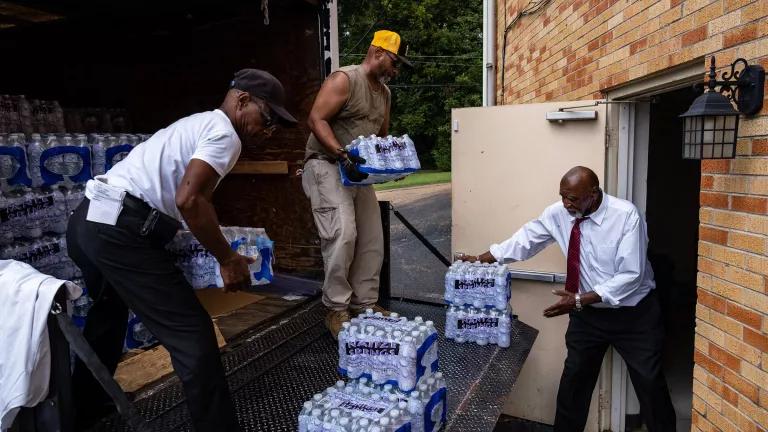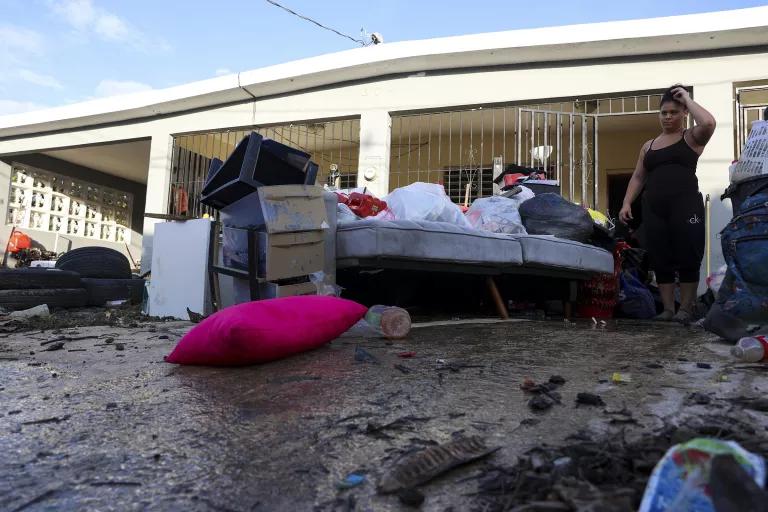Mutual Aid and Disaster Justice: “We Keep Us Safe”
As climate-fueled disasters become more frequent—from Mississippi to Puerto Rico and beyond—relief efforts by communities, for communities, could become increasingly critical.

Members of Progressive Morningstar Baptist Church supply cases of water to residents of Jackson, Mississippi, as flooding in the city left people without clean running water for nearly a week on September 4, 2022.
When Hurricane Fiona struck Puerto Rico in mid-September, it brought devastating floods and mudslides and knocked out power on the entire island. Immediately after the storm, established local groups began helping out by distributing food, water, toiletries, and medical supplies. And others, who built solar capacity in the wake of Hurricane Maria five years ago, shared their energy supply. By the end of September, another group, Central Florida Mutual Aid, mobilized to coordinate access to meals, water, shelter, and transportation for Floridians dealing with the devastation wrought by Hurricane Ian.
A similar scenario took place in late August when torrential rains poured over Jackson, Mississippi, causing the Pearl River to inundate neighborhoods and the city’s main water treatment plant; more than 150,000 residents found themselves without running water for a week. In this majority-Black, and significantly low-income city that’s been long plagued by unsafe drinking water (and that had already been under a boil-water advisory for a month when the storm hit), local groups like Cooperation Jackson were similarly prepared. They swung into action, distributing bottled water and supplies to their neighbors.
The rapid responses to extreme weather that happened across southwestern Florida, Puerto Rico, and Jackson were examples of mutual aid, a support system in which community members come together against a common struggle.
“It's about sharing resources, but it’s also about sharing power. Everybody gives what they're able and receives what they need in a way that breaks down power imbalance,” says Jimmy Dunson, cofounder of Mutual Aid Disaster Relief, which he describes as a people-powered national disaster relief network focused on the principle of solidarity—not charity.
In recent years, local residents have been organizing themselves and providing resources to their neighbors in areas pounded by hurricanes, scorched by wildfires, or crippled by heat waves. And as such climate-fueled disasters become more frequent and threaten more people in more places, rapid-response mutual aid efforts could become increasingly vital.
Mutual aid is, of course, nothing new. For many Indigenous people, this kind of collective care is a way of life. And Black and other marginalized communities have for centuries relied on mutual aid as a response to, and a rejection of, the injustices they’ve faced. Historically denied equal access to recovery resources such as loans and government aid, the members of these communities often depended on one another to get by—pooling money, sharing food, and providing transportation or other needed resources.
“A rallying cry of mutual aid is ‘we keep us safe,’” says Anna Weber, an NRDC policy analyst who works on flood protection and climate adaptation policy. The idea has recently gained even more traction in communities all around the country, especially in response to the COVID-19 pandemic. “There is a lot more awareness in the general public about how disasters can affect anyone, at any time—even if you live in a place that hasn't been as exposed to these hazards.”
Mutual aid: filling the gaps in disaster relief
When disaster strikes, government agencies often act like slow-turning ships. During these times, mutual aid can be critical because on-the-ground groups are quicker and more nimble, allowing them to get urgent help to those who need it. And because mutual aid groups are local, they are more familiar with a community’s values, needs, and priorities than other helpers based hundreds of miles away.
Such was the case with Imagine Water Works (IWW), a New Orleans–based group. IWW has been coordinating mutual aid efforts in the city for the past four years and has been working to reduce flooding and pollution risks for a decade. So when Hurricane Ida hit last summer, the group was ready for it. As community members themselves who represented several generations, IWW was able to connect easily with other residents and help gather and distribute aid and set up relief tents right away. Within a week of Ida’s landfall, IWW redirected more than $90,000 in donations to other local funds across the region.
Dr. Samantha Montano, an emergency management expert and author of the book Disasterology: Dispatches from the Frontlines of the Climate Crisis, explains that after a disaster, the Federal Emergency Management Agency (FEMA) does help individuals to recover, but focuses more on public assistance efforts like repairing damaged infrastructure. And while local and state governments, along with utilities, are the first responders in a disaster, mutual aid groups, along with nonprofits, churches, and other community organizations fill the gap in immediate assistance for residents. Later on, the federal government may also rely on these local groups to advertise their own services—some advocacy groups offer pro bono legal guidance to help people submit FEMA paperwork for flood remittance, for example, and navigate other barriers to accessing aid.
But this approach is unsustainable. “It becomes an issue of scale. As you have increasing numbers of disasters, increasing risk, and increasing need across the country, we're seeing more and more people who are looking for disaster-related assistance,” Montano says. This heightened demand is outpacing the capacities of nonprofits and mutual aid groups. And so the gaps left by limited government relief widen.
Disaster justice
Those gaps don’t affect people equally. Some of Puerto Rico’s lowest-income residents live in high-risk flood zones, and often in homes that don’t follow formal building codes. Many are forced to rely on community centers for basic electricity needs when strong storms knock out power, like we saw recently with Hurricanes Fiona and Ian. Or consider last year’s Hurricane Ida, which left federally unrecognized tribes and undocumented immgrants suffering and without access to government aid. Environmental racism has too often put marginalized communities like these on the frontlines of our global climate crisis.
“Everything about disasters before, during, and after tends to fall along the lines of race, class, gender, and ability—lots of intersections,” Montano says. Underinvestment in low-income communities, for example, leaves these residents more at risk and least prioritized by response and recovery efforts. “Unfortunately, the way our emergency management system is designed, it often compounds those inequalities—or at the very least, does not address them,” she says. Montano adds that disaster justice would benefit from promoting equity in not only how we respond to disasters but how we mitigate and prepare for them too.
And those actions in anticipation of a potential disaster—such as updating floodplain maps and making buildings, roads, and bridges more resilient to extreme weather—can reduce the harms that require recovery later.
“A disaster happens when a hazard intersects with human decisions about where we live, how we live, and how we structure our society,” Weber says. “We have the power to change those things, to address those underlying vulnerabilities. Addressing systemic racism and poverty and inequality is one of the most important things that we can be doing for climate adaptation as a nation.”
Emergency management reform
Accessing government aid in the wake of a disaster is not quick or easy. “There’s a myth that when disaster strikes, FEMA shows up and essentially drops bags of money out of airplanes. That’s the furthest thing from the truth,” Weber says. First, assistance from the federal government requires a disaster declaration, which is harder to come by in rural areas or where the financial value of the damage is low. Second, even if victims qualify, the average FEMA payout from the Individuals and Households Assistance Program is only several thousand dollars—not nearly enough to rebuild a home or do any other substantial recovery work.
In response, Montano is calling for a comprehensive emergency management reform across the United States. She says FEMA needs to increase individual assistance and improve its system for delivering those funds, which would build on last year’s critical reform making it easier for people to self-certify homeownership to the agency in the wake of a disaster. (The agency has also made additional assistance available to people whose homes are damaged, but still habitable, and expanded assistance to people who suffered disabling injuries due to the disaster.) Another helpful change would be to bolster the capacity of nonprofits to help with rebuilding and other recovery efforts through sharing resources, connecting with local emergency management agencies, and coordinating more efficiently to avoid duplicating services. NRDC has also called for FEMA to invest more of its resources in building the capacity of low-income and disadvantaged communities. Too often, these communities may not have a full-time emergency manager or floodplain manager. This lack of capacity inhibits these communities’ ability to plan for future disasters, take steps to reduce their vulnerability, or even apply for additional funding to carry out projects that would make their communities safer.
But policy change at the federal level is only part of the reform we need. “You can make changes at the federal level but if it isn’t in coordination at the state and local levels, where most of our management policy exists,” she says, “you're not necessarily going to solve the problem that you're trying to solve.”

Think locally, act locally
Just as mutual aid groups provide critical disaster relief to local communities, so must local governments step up their responses through policy changes that reduce risk and vulnerability in the first place—through more funding for social services or investments in infrastructure projects like drainage systems. Because so much emergency management policy exists at the local and state levels, communities don’t have to be completely dependent on the federal government. “As we wait for Congress to wake up and realize the dramatic need for federal reform, there are changes that we can be working on more locally,” Montano says. Learning about emergency management and who makes the decisions about climate resilience projects in your town or city are other ways to get involved in reforms.
And even if sweeping emergency management reforms come to pass, mutual aid will remain pivotal as the consequences of a warming world continue to unfold. “One of the most important preparedness actions you can do is to just get to know your neighbors so that you can be there for each other and support each other if something happens,” Weber says. That’s a huge component of disaster preparedness that she says often doesn’t get talked about.
Dunson agrees. “All of these recent disasters have made it clear that we have to take care of each other,” he says. “There's no cavalry coming in. We're all we have.”
This NRDC.org story is available for online republication by news media outlets or nonprofits under these conditions: The writer(s) must be credited with a byline; you must note prominently that the story was originally published by NRDC.org and link to the original; the story cannot be edited (beyond simple things such as grammar); you can’t resell the story in any form or grant republishing rights to other outlets; you can’t republish our material wholesale or automatically—you need to select stories individually; you can’t republish the photos or graphics on our site without specific permission; you should drop us a note to let us know when you’ve used one of our stories.


What Are the Effects of Climate Change?
Heat Stress Is Killing Workers. States Can Protect Them.
Climate Change at the Doctor’s Office